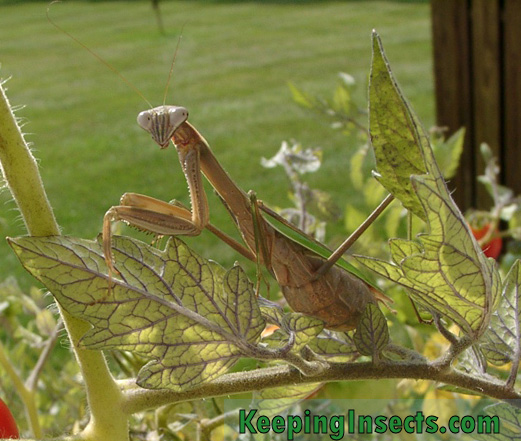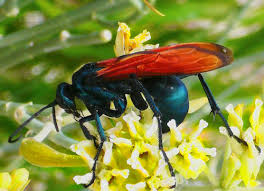Post by rock on May 2, 2019 21:12:47 GMT 5
chinese mantis-mantie
The Chinese mantis (Tenodera sinensis) is a species of praying mantis native to Asia and the nearby islands. In 1896 this species was accidentally introduced by a nurseryman at Mt. Airy near Philadelphia, United States.[2] Tenodera sinensis often is erroneously referred to as Tenodera aridifolia sinensis because it was at first described as a subspecies of Tenodera aridifolia, but Tenodera sinensis is now established as a full species.
Tenodera sinensis feeds primarily on other insects, though adult females sometimes catch small vertebrates. For example, they have been documented as feeding on lizards ,spiders, hornets, katydids, snakes, small frogs, and even hummingbirds.Like most mantids, they are known to be cannibalistic. These mantids have been observed eating the larvae of monarch butterflies, while discarding the entrails.The Chinese mantis is a long, slender, brown and green praying mantis. It is typically longer than other praying mantises species reaching just over 11 cm (4.3 in), and is the largest mantis species in North America (spread throughout the Northeast United States). Its color can vary from overall green to brown with a green lateral stripe on the borders of the front wings in the brown color form. In low light the eyes of the mantis appear black, but in daylight appear to be clear, matching the color of the head. Chinese mantids look similar to another mantis species that has been introduced to the United States, the narrow-winged mantid (Tenodera angustipennis). Tenodera sinensis and Tenodera angustipennis are similar in appearance, however you can tell them apart by locating a spot in between their front legs. If it is yellow then it is a Chinese mantis but if it is orange then it is a narrow-winged mantis. The female can produce several semi-spherical oothecae, roughly 2 cm (0.8 in) in diameter, containing up to 400 eggs. The oothecae are often affixed to vegetation such as bushes and small trees.

tarantula hawk wasp-pepsi wasp
The more familiar species are up to 5 cm (2 in) long, making them among the largest of wasps, and have blue-black bodies and bright, rust-colored wings (other species have black wings with blue highlights). The vivid coloration found on their bodies, and especially wings, is an aposematism, advertising to potential predators the wasps' ability to deliver a powerful sting. Their long legs have hooked claws for grappling with their victims. The stinger of a female Pepsis grossa can be up to 7 mm (9⁄32 in) long, and the powerful sting is considered one of the most painful insect stings in the world.The female tarantula hawk wasp stings and paralyzes a tarantula, then drags the prey to a specially prepared brooding nest, where a single egg is laid on the spider's abdomen, and the entrance is covered.[3] Sex of the larvae is determined by fertilization; fertilized eggs produce females, while unfertilized eggs produce males.[3] When the wasp larva hatches, it creates a small hole in the spider's abdomen, then enters and feeds voraciously, avoiding vital organs for as long as possible to keep the spider alive. After several weeks, the larva pupates. Finally, the wasp becomes an adult and emerges from the spider's abdomen to continue the life cycle.
Adult tarantula hawks are nectarivorous. The consumption of fermented fruit sometimes intoxicates them to the point that flight becomes difficult. While the wasps tend to be most active in the daytime in summer, they tend to avoid high temperatures. The male tarantula hawk does not hunt; instead, it feeds off the flowers of milkweeds, western soapberry trees, or mesquite trees (females feed on these same plants, as well). Male tarantula hawks have been observed practicing a behavior called hill-topping, in which they sit atop tall plants and watch for passing females ready to reproduce. Females are not very aggressive, in that they are hesitant to sting, but the sting is extraordinarily painful.Tarantula hawk wasps are relatively docile and rarely sting without provocation. However, the sting—particularly that of P. grossa—is among the most painful of all insects, though the intense pain only lasts about five minutes.[8] One researcher described the pain as "...immediate, excruciating, unrelenting pain that simply shuts down one's ability to do anything, except scream. Mental discipline simply does not work in these situations."[5] In terms of scale, the wasp's sting is rated near the top of the Schmidt sting pain index, second only to that of the bullet ant, and is described by Schmidt as "blinding, fierce[, and] shockingly electric".[2] Because of their extremely large stingers, very few animals are able to eat them; one of the few that can is the roadrunner. Many predatory animals avoid these wasps, and many different insects mimic them, including various other wasps and bees (Müllerian mimics), as well as moths, flies (e.g., mydas flies), and beetles (e.g., Tragidion) (Batesian mimics).
Aside from the possibility of triggering an allergic reaction, the sting is not dangerous and does not require medical attention. Local redness appears in most cases after the pain, and lasts for up to a week.

The Chinese mantis (Tenodera sinensis) is a species of praying mantis native to Asia and the nearby islands. In 1896 this species was accidentally introduced by a nurseryman at Mt. Airy near Philadelphia, United States.[2] Tenodera sinensis often is erroneously referred to as Tenodera aridifolia sinensis because it was at first described as a subspecies of Tenodera aridifolia, but Tenodera sinensis is now established as a full species.
Tenodera sinensis feeds primarily on other insects, though adult females sometimes catch small vertebrates. For example, they have been documented as feeding on lizards ,spiders, hornets, katydids, snakes, small frogs, and even hummingbirds.Like most mantids, they are known to be cannibalistic. These mantids have been observed eating the larvae of monarch butterflies, while discarding the entrails.The Chinese mantis is a long, slender, brown and green praying mantis. It is typically longer than other praying mantises species reaching just over 11 cm (4.3 in), and is the largest mantis species in North America (spread throughout the Northeast United States). Its color can vary from overall green to brown with a green lateral stripe on the borders of the front wings in the brown color form. In low light the eyes of the mantis appear black, but in daylight appear to be clear, matching the color of the head. Chinese mantids look similar to another mantis species that has been introduced to the United States, the narrow-winged mantid (Tenodera angustipennis). Tenodera sinensis and Tenodera angustipennis are similar in appearance, however you can tell them apart by locating a spot in between their front legs. If it is yellow then it is a Chinese mantis but if it is orange then it is a narrow-winged mantis. The female can produce several semi-spherical oothecae, roughly 2 cm (0.8 in) in diameter, containing up to 400 eggs. The oothecae are often affixed to vegetation such as bushes and small trees.

tarantula hawk wasp-pepsi wasp
The more familiar species are up to 5 cm (2 in) long, making them among the largest of wasps, and have blue-black bodies and bright, rust-colored wings (other species have black wings with blue highlights). The vivid coloration found on their bodies, and especially wings, is an aposematism, advertising to potential predators the wasps' ability to deliver a powerful sting. Their long legs have hooked claws for grappling with their victims. The stinger of a female Pepsis grossa can be up to 7 mm (9⁄32 in) long, and the powerful sting is considered one of the most painful insect stings in the world.The female tarantula hawk wasp stings and paralyzes a tarantula, then drags the prey to a specially prepared brooding nest, where a single egg is laid on the spider's abdomen, and the entrance is covered.[3] Sex of the larvae is determined by fertilization; fertilized eggs produce females, while unfertilized eggs produce males.[3] When the wasp larva hatches, it creates a small hole in the spider's abdomen, then enters and feeds voraciously, avoiding vital organs for as long as possible to keep the spider alive. After several weeks, the larva pupates. Finally, the wasp becomes an adult and emerges from the spider's abdomen to continue the life cycle.
Adult tarantula hawks are nectarivorous. The consumption of fermented fruit sometimes intoxicates them to the point that flight becomes difficult. While the wasps tend to be most active in the daytime in summer, they tend to avoid high temperatures. The male tarantula hawk does not hunt; instead, it feeds off the flowers of milkweeds, western soapberry trees, or mesquite trees (females feed on these same plants, as well). Male tarantula hawks have been observed practicing a behavior called hill-topping, in which they sit atop tall plants and watch for passing females ready to reproduce. Females are not very aggressive, in that they are hesitant to sting, but the sting is extraordinarily painful.Tarantula hawk wasps are relatively docile and rarely sting without provocation. However, the sting—particularly that of P. grossa—is among the most painful of all insects, though the intense pain only lasts about five minutes.[8] One researcher described the pain as "...immediate, excruciating, unrelenting pain that simply shuts down one's ability to do anything, except scream. Mental discipline simply does not work in these situations."[5] In terms of scale, the wasp's sting is rated near the top of the Schmidt sting pain index, second only to that of the bullet ant, and is described by Schmidt as "blinding, fierce[, and] shockingly electric".[2] Because of their extremely large stingers, very few animals are able to eat them; one of the few that can is the roadrunner. Many predatory animals avoid these wasps, and many different insects mimic them, including various other wasps and bees (Müllerian mimics), as well as moths, flies (e.g., mydas flies), and beetles (e.g., Tragidion) (Batesian mimics).
Aside from the possibility of triggering an allergic reaction, the sting is not dangerous and does not require medical attention. Local redness appears in most cases after the pain, and lasts for up to a week.






